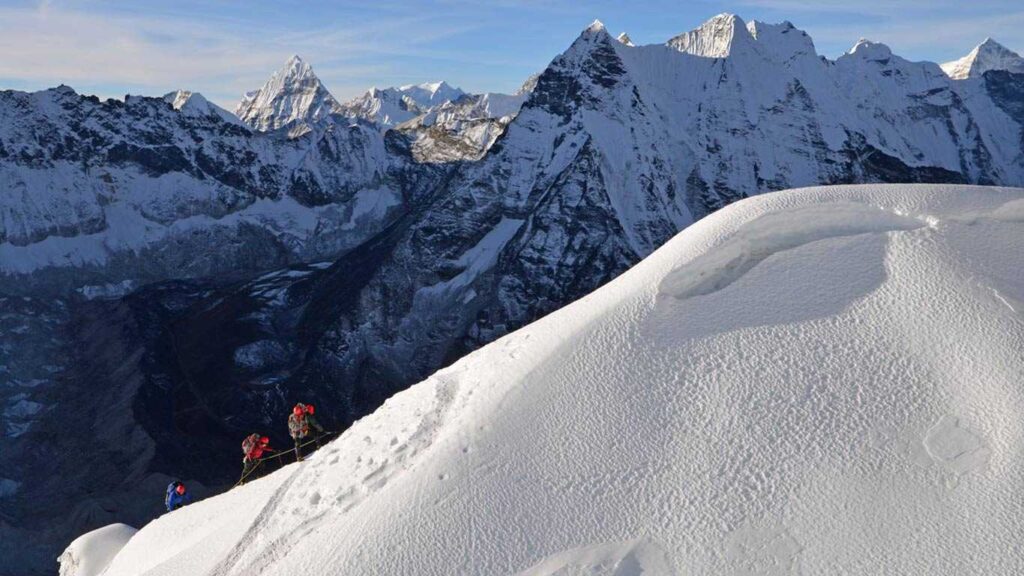
How Hard is Island Peak Climbing?

Island Peak, also known as Imja Tse, is one of the most popular trekking peaks in Nepal, located in the Everest region. While it is considered a technically straightforward climb, it still presents significant challenges due to its altitude, steep sections, and variable weather conditions. Here’s an overview of the difficulty of climbing this Peak:
Altitude:
- Island Peak stands at an elevation of 6,189 meters (20,305 feet) above sea level. Altitude-related challenges such as decreased oxygen levels, thin air, and potential altitude sickness are significant factors climbers must contend with.
Technical Difficulty:
- While this Peak is often classified as a non-technical climb, it does involve some technical sections, including steep ascents, snow slopes, and a glacier traverse. Climbers must use basic mountaineering techniques such as walking in crampons, using an ice axe, and rope techniques for safety on exposed sections.
- The final summit push involves a steep climb up a rocky ridge followed by a 45-degree snow slope to the summit. This section requires good physical fitness, stamina, and careful footwork.
Weather Conditions:
- Weather conditions on this Peak can be unpredictable and harsh, particularly during the climbing season. High winds, snowstorms, and rapid changes in weather are common, posing additional challenges to climbers.
- Climbers must be prepared to adapt to changing weather conditions and make decisions based on safety considerations.
Physical Fitness:
- Climbing Island Peak requires a good level of physical fitness and endurance. Climbers should be able to hike for long hours with a heavy pack, ascend steep terrain, and cope with the effects of high altitude.
- Prior mountaineering experience or experience trekking at high altitudes is beneficial but not mandatory. However, climbers should be prepared to undergo training and conditioning before attempting the climb.
Acclimatization:
- Proper acclimatization is crucial for a successful ascent of this Peak. Climbers should follow a well-paced itinerary that allows for gradual altitude gain, rest days for acclimatization, and adequate hydration.
- The climb typically includes acclimatization days in the nearby villages of Dingboche and Chukhung before attempting the summit.
Overall, while Island Peak is technically achievable for climbers with moderate mountaineering experience, it should not be underestimate. Proper preparation, training, acclimatization, and the guidance of experienced guides are essential for a safe and successful climb.
Certainly! Here are some frequently asked questions (FAQs) about Island Peak climbing:
- What is Island Peak?
- Island Peak, also known as Imja Tse, is a popular trekking peak located in the Everest region of Nepal. It stands at an elevation of 6,189 meters (20,305 feet) above sea level and offers stunning views of the surrounding Himalayan peaks.
- Do I need prior mountaineering experience to climb Island Peak?
- While prior mountaineering experience is not mandatory, it is beneficial to have some experience with basic mountaineering techniques such as walking in crampons, using an ice axe, and rope skills. Many climbers undertake this peak as their first Himalayan climbing experience with the guidance of experienced guides.
- When is the best time to climb Island Peak?
- The best time for climbing Island Peak is during the pre-monsoon (spring) and post-monsoon (autumn) seasons, from March to May and September to November, respectively. These months offer stable weather, clear skies, and favorable climbing conditions.
- Do I need a permit to climb Island Peak?
- Yes, climbers need a climbing permit issued by the Nepal Mountaineering Association (NMA) to climb Island Peak. The climbing permit includes entry into the Sagarmatha National Park and other necessary permits for the trekking route.
- What is the difficulty level of climbing Island Peak?
- This Peak considered a technically straightforward climb, but it still presents significant challenges due to its altitude, steep sections, and variable weather conditions. Climbers should be in good physical condition and prepared for long days of trekking and climbing.
- What is the typical duration of the Island Peak climbing expedition?
- The duration of this Peak climbing expedition varies depending on the chosen itinerary and acclimatization schedule. Generally, the climb takes around 16-20 days, including trekking to and from Lukla, acclimatization days, and summit day.
- What equipment do I need for climbing Island Peak?
- Climbers need basic mountaineering equipment such as crampons, ice axe, harness, helmet, ropes, and climbing boots. Additionally, warm clothing, sleeping bags, trekking poles, and personal gear are essential for the trek and climb.
- Is it safe to climb Island Peak?
- With proper preparation, experienced guides, and adherence to safety protocols, climbing this peak can be a safe and rewarding experience. However, climbers should aware of the risks relating problems with high-altitude mountaineering and prepare for the challenges it presents.
These are some of the frequently asked questions about climbing this Peak. If you have any specific inquiries or concerns, feel free to ask!
